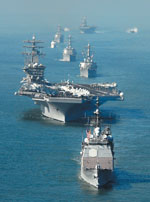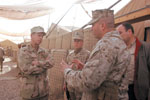Navy Looks to More Ships for More Missions
 |
| The USS Princeton and the USS Nimitz lead a collection of U.S. Navy, Marine Corps and Coast Guard ships. The Navy is restructuring to interoperate with a host of ships from outside of its fleet, including those of foreign navies, as it addresses a range of new missions worldwide. |
The U.S. Navy cannot become fully network centric quickly enough to be able to carry out its new diverse mission slate, according to its top military officer. Adm. Michael G. Mullen, USN, chief of naval operations, states that new missions and the potential for a greater number of nations to participate in them add up to increased reliance on the network and its capabilities.
The Navy is operating in a more dispersed manner, which the admiral attributes to its networked nature. It will operate in new venues and with ships that it has not interoperated with before. These new ships include classes of platforms that the Navy currently is launching or developing, as well as the ships of other nations networked for cooperation against common foes.
Combining U.S. Navy forces with those of other nations to carry out new types of missions is known as the 1,000-ship navy concept. Instead of subjecting the U.S. Navy to a massive shipbuilding program, this approach would integrate other nations’ ships with
The admiral explains that this concept allows maritime capabilities, from the low end to the high end, to operate in partnerships to address diverse challenges in both territorial and international waters. These may include activities such as counterdrug, weapons interdiction, fisheries monitoring and antipiracy missions.
Taking on these new tasks may not require much money or sophisticated technology or operating procedures, the admiral emphasizes. “We think we can help many navies or maritime forces in ways that we have not done in the past,” he states. The admiral adds that many defense chiefs around the world have expressed a great deal of interest in this approach.
In the 1,000-ship concept, the network will provide a new approach to security at sea, Adm. Mullen offers. Historically, this security tended to rely on concealment or evasion from detection. But now, the networks of the world will provide security through identification, he suggests. Automatic identification, such as that required by the International Maritime Organization, is just the beginning of that network-centric paradigm shift. “We are moving to a point where every single thing afloat, down to a jetski, is going to have some kind of identification system on it,” the admiral predicts.
This adds even greater importance to the network. While network centricity and its capabilities are changing the way the Navy does business—and have been for some time—the Navy is lagging in some aspects. “Like many things, we’re not going fast enough,” Adm. Mullen states. “We’re not investing enough, and we’re not taking advantage of the technology that is out there because we’re far too bogged down in our acquisition system and our bureaucracy to deliver what I know can be delivered—and I’m really frustrated by that.
“The technology and the networks are moving fast enough, but I don’t believe that we’re moving fast enough to catch them, to be where I need to be,” he continues. “It needs to be a principal warfighting capability—it may even be the principal warfighting capability. We all like guns and bombs and missiles, but this is an area that is front and center for the future of warfare,” the admiral emphasizes.
“We are a networked force,” he states, explaining why he stood up the separate N-6 office earlier this year. He asserts that Vice Adm. Mark J. Edwards, USN, the N-6, and Vice Adm. James D. McArthur Jr., USN, the commander of the Naval Network Warfare Command, are the two people who will bring the network-centric capability to fruition. “I’m tired of talking about it,” Adm. Mullen declares. “We need to deliver.”
The admiral also calls for greater emphasis on information operations, particularly on the network. “I think we underplay the threat in terms of what it can do to us—in terms of network attack or network defense—and we need to be the world leader in those areas and to be able to leverage the technology in the networks out there.”
Among the priorities that Adm. Mullen has placed at the top of his list since he took the helm as chief of naval operations (CNO) a little more than a year ago are to keep the fleet running at a high level and to determine how to build the future. Building the future requires reversing a long-term reduction in fleet size, Adm. Mullen offers. During the late 1980s, the Navy came close to its goal of 600 ships. But, that number faded into memory as the fleet shrank to less than 300 ships. The admiral relates that it dropped to little more than 280, and if unchecked the decline in ship numbers would have continued until the Navy had only about 200 to 220 ships.
His office assembled a plan for expanding the fleet to meet its new missions, and it established a strategic relationship with Congress to ensure that the Navy received the resources it needs to carry out its plans. The analysis for this effort took about eight months, he relates, for inclusion in the fiscal year 2007 budget. The admiral describes Congress as “very supportive” in the 2007 authorization appropriations bill that was reported out in October. The result is a balanced fleet comprising 313 ships.
Cost remains a big issue. The admiral states that recently implemented mechanisms have helped clamp down on requirements creep and cost growth. Cost limits on individual platforms—such as the Virginia-class submarine and the first DDG-21 destroyer—have been established for every major program.
Other new platforms are in the works to support the Navy’s needs. The Navy has expanded its mission set to include green water and brown water operations. In May the newly created Naval Expeditionary Combat Command stood up Riverine Group 1, and this group will deploy to
 |
| Adm. Mullen (l) is briefed by Brig. Gen. John Wissler, USMC (r), commanding general, 2nd Marine Logistics Group, at Camp Taqaddum in Iraq. The Navy currently has more people on the ground in the U.S. Central Command’s area of responsibility than it does at sea in that same region. |
A related challenge is how to get shallow-water ships close into shore. The solution may have come down the waterways in October when the Navy christened the USS Freedom, LCS-1. The admiral describes this ship as the culmination of a dream from three years ago. The new ship offers only a 15-foot draft and can achieve speeds in excess of 45 knots.
Adm. Mullen offers that one key LCS-1 characteristic that often is overlooked is its modularity. This modularity will allow the ship to flex with future missions as they arise as well as to modernize where and when needed. The Navy is a year away from commissioning the ship—and much work remains to be done on it—but the admiral is very excited about the capabilities it promises to bring to the fleet.
Another vital capability that soon may have a greater presence in the Navy is missile defense. The Navy participated significantly in operations during last summer’s
Adm. Mullen says the Navy does not yet know where naval forces fit into the missile-defense world, but it has a growing capability that can provide vital service. “We’ve invested some $80 billion in those cruisers and destroyers,” he points out. “We need to leverage that correctly for missile defense in the future.”
One key nontechnological priority focuses on Navy personnel. Adm. Mullen declares the need “to make sure we have it right for our people” in terms of having the best personnel available and keeping them satisfied in their roles and their family lives.
“We can build all the stuff in the world, we can have all the missions in the world, but if we don’t have high-quality people to execute it, then we are not going to do anything,” he warrants. “We have the best level of talent that I’ve seen in almost four decades of being in the Navy. I don’t take that for granted, and I don’t take their service for granted.”
This nontechnological piece is very complex, he adds. This support requires a strategy for personnel issues, including those of family members. Adm. Mullen states that he has spent considerable time developing that strategy over the past year.
This break with the past includes greater emphasis on language skills and civil affairs. It includes a career path for what the admiral calls foreign area officers. The Navy also has more of a need for a large master of arms security force, which right now is about 10 times as big as it was prior to the September 11, 2001, terrorist attacks. This force would perform more missions ashore, particularly overseas.
And, these personnel issues affect many other Navy plans. Adm. Mullen emphasizes that the Navy needs to be able to operate with the Marine Corps in a distributed fashion in the future. But the Marine Corps is stretched thin by the war in
Other forces are stretched by the war. The Seabees, for example, also have been deployed with the Marines in the U.S. Central Command (CENTCOM) area of responsibility, and they have been serving in overseas operations as long as they have been home. Navy SEALS and special operations support forces also have been involved in the war heavily. Active-duty and Reserve doctors, corpsmen and nurses have been performing “miracle after miracle after miracle,” the admiral states. About 300 medical personnel are going to deploy to
The Navy currently is transitioning to a state of “continuous readiness,” Adm. Mullen says. Instead of cyclical preparations before deployments, the Global War on Terrorism requires constant operational capability. “Whether it’s a warfight or a natural disaster—and they seem to be coming more frequently—we must be much more ready for responding to this very uncertain world than the regimented fashion in the past.”
The admiral adds that six O-5 command-at-sea-screened officers are in command of six of the provincial reconstruction teams in
The admiral offers that one of the biggest changes being instituted by the Navy is the creation of command centers and concepts for maritime operational headquarters. He describes this concept as similar to an air operations center. These headquarters are being put in place principally through the Navy’s fleet commanders who effectively serve as maritime component commanders under combatant commanders.
Adm. Mullen describes this effort as a huge shift for the Navy in that it institutionalizes both old and new practices. It will require a level of command and control and investment in both doctrine and capabilities across the board, rather than piecemeal. Achieving it will be a huge challenge, he states.
Web Resources
Chief of Naval Operations (CNO): www.navy.mil/navydata/leadership/ldrDisplay.asp?m=11
CNO on the 1,000-ship navy: www.navy.mil/navydata/leadership/quotes.asp?q=11&c=2
Navy FY 2007 Budget: www.finance.hq.navy.mil/fmb/07pres/books.htm
Naval Network Warfare Command: https://ekm.netwarcom.navy.mil/netwarcom/nnwc-nipr/index.htm



Comments